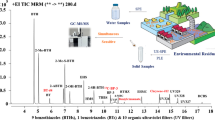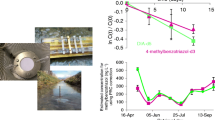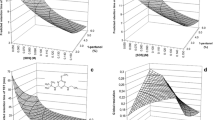Abstract
Benzophenone-type UV filters (BPs) are ubiquitous in the environment. Transformation products (TPs) of BPs with suspected toxicity are likely to be produced during disinfection of water by chlorination. To quickly predict the toxicity of TPs, in this study, a novel two-dimensional liquid-chromatography (2D-LC) method was established in which the objective of the first dimension was to separate the multiple components of the BPs sample after chlorination, using a reversed-phase liquid-chromatography mode. A biochromatographic system, i.e. bio-partitioning micellar chromatography with the polyoxyethylene (23) lauryl ether aqueous solution as the mobile phase, served as the second dimension to predict the toxicity of the fraction from the first dimension on the basis of the quantitative retention–activity relationships (QRARs) model. Six BPs, namely 2,4-dihydroxybenzophenone, oxybenzone, 4-hydroxybenzophenone, 2-hydroxy-4-methoxybenzophenone-5-sulfonic acid, 2,2'-dihydroxy-4,4'-dimethoxybenzophenone and 2,2'-dihydroxy-4-methoxybenzophenone, were the target analytes subjected to chlorination. The products of these BPs after chlorination were directly injected to the 2D-LC system for analysis. The results indicated that most TPs may be less toxic than their parent chemicals, but some may be more toxic, and that intestinal toxicity of TPs may be more obvious than blood toxicity. The proposed method is time-saving, high-throughput, and reliable, and has great potential for predicting toxicity or bioactivity of unknown and/or known components in a complex sample.

The scheme for the 2D-LC online prediction of toxicity of the transformation products of benzophenone-type UV filters after chlorination







Similar content being viewed by others
References
Ternes TA, Joss A, Siegrist H (2004) Scrutinizing pharmaceuticals and personal care products in wastewater treatment. Environ Sci Technol 38:392A–399A
Kupper T, Plagellat C, Brandli RC, de Alencastro LF, Grandjean D, Tarradellas J (2006) Fate and removal of polycyclic musks, UV filters and biocides during wastewater treatment. Water Res 40:2603–2612
Poiger T, Buser HR, Balmer ME, Bergqvist PA, Muller MD (2004) Occurrence of UV filter compounds from sunscreens in surface waters: regional mass balance in two Swiss lakes. Chemosphere 55:951–963
Balmer ME, Buser HR, Muller MD, Poiger T (2005) Occurrence of some organic UV filters in wastewater, in surface waters, and in fish from Swiss. Lakes Environ Sci Technol 39:953–962
Negreira N, Canosa P, Rodriguez I, Ramil M, Rubi E, Cela R (2008) Study of some UV filters stability in chlorinated water and identification of halogenated by-products by gas chromatography-mass spectrometry. J Chromatogr A 1178:206–214
Deborde M, von Gunten U (2008) Reactions of chlorine with inorganic and organic compounds during water treatment-Kinetics and mechanisms: a critical review. Water Res 42:13–51
DellaGreca M, Iesce MR, Pistillo P, Previtera L, Temussi F (2009) Unusual products of the aqueous chlorination of atenolol. Chemosphere 74:730–734
Yang X, Shang C (2004) Chlorination byproduct formation in the presence of humic acid, model nitrogenous organic compounds, ammonia, and bromide. Environ Sci Technol 38:4995–5001
Buth JM, Arnold WA, McNeill K (2007) Unexpected products and reaction mechanisms of the aqueous chlorination of cimetidine. Environ Sci Technol 41:6228–6233
Liu Q, Chen Z, Wei D, Du Y (2014) Acute toxicity formation potential of benzophenone-type UV filters in chlorination disinfection process. J Environ Sci 26:440–447
Xiao M, Wei D, Yin J, Wei G, Du Y (2013) Transformation mechanism of benzophenone-4 in free chlorine promoted chlorination disinfection. Water Res 47:6223–6233
Suzuki T, Kitamura S, Khota R, Sugihara K, Fujimoto N, Ohta S (2005) Estrogenic and antiandrogenic activities of 17 benzophenone derivatives used as UV stabilizers and sunscreens. Toxicol Appl Pharmacol 203:9–17
Zeiger E, Anderson B, Haworth S, Lawlor T, Mortelmans K, Speck W (1987) Salmonella mutagenicity tests: III Results from the testing of 255 chemicals. Environ Mutagen 9(Suppl 9):1–109
French JE (1992) NTP technical report on the toxicity studies of 2-Hydroxy-4-methoxybenzophenone (CAS No 131-57-7) Administered Topically and in Dosed Feed to F344/N Rats and B6C3F1 Mice. Toxic Rep Ser 21:1–14
Maijo I, Fontanals N, Borrull F, Neususs C, Calull M, Aguilar C (2013) Determination of UV filters in river water samples by in-line SPE-CE-MS. Electrophoresis 34:374–382
Siroka Z, Svobodova Z (2013) The toxicity and adverse effects of selected drugs in animals—overview. Pol J Vet Sci 16:181–191
Tiwari AK, Pragya P, Ravi RK, Chowdhuri DK (2011) Environmental chemical mediated male reproductive toxicity: Drosophila melanogaster as an alternate animal model. Theriogenology 76:197–216
Scott CW, Peters MF, Dragan YP (2013) Human induced pluripotent stem cells and their use in drug discovery for toxicity testing. Toxicol Lett 219:49–58
Greenhough S, Medine CN, Hay DC (2010) Pluripotent stem cell derived hepatocyte like cells and their potential in toxicity screening. Toxicology 278:250–255
Escuder-Gilabert L, Martinez-Pla JJ, Sagrado S, Villanueva-Camanas RM, Medina-Hernandez MJ (2003) Biopartitioning micellar separation methods: modelling drug absorption. J Chromatogr B Analyt Technol Biomed Life Sci 797:21–35
Yin CR, Ma LY, Huang JG, Xu L, Shi ZG (2013) Fast profiling ecotoxicity and skin permeability of benzophenone ultraviolet filters using biopartitioning micellar chromatography based on penetrable silica spheres. Anal Chim Acta 804:321–327
Martinez-Pla JJ, Martin-Biosca Y, Sagrado S, Villanueva-Camanas RM, Medina-Hernandez MJ (2004) Evaluation of the pH effect of formulations on the skin permeability of drugs by biopartitioning micellar chromatography. J Chromatogr A 1047:255–262
Molero-Monfort M, Escuder-Gilabert L, Villanueva-Camanas RM, Sagrado S, Medina-Hernandez MJ (2001) Biopartitioning micellar chromatography: an in vitro technique for predicting human drug absorption. J Chromatogr B Biomed Sci Appl 753:225–236
Hu Z, Zhang W, He H, Feng Y, Da S (2009) Profiling of permeable compounds in Ligusticum chuanxiong by biopartitioning micellar chromatography. Chromatographia 69:637–644
Quinones-Torrelo C, Sagrado-Vives S, Villanueva-Camanas RM, Medina-Hernandez MJ (2001) An LD50 model for predicting psychotropic drug toxicity using biopartitioning micellar chromatography. Biomed Chromatogr 15:31–40
Bermudez-Saldana JM, Escuder-Gilabert L, Medina-Hernandez MJ, Villanueva-Camanas RM, Sagrado S (2005) Modelling bioconcentration of pesticides in fish using biopartitioning micellar chromatography. J Chromatogr A 1063:153–160
Zhang C, Li J, Xu L, Shi ZG (2012) Fast immobilized liposome chromatography based on penetrable silica microspheres for screening and analysis of permeable compounds. J Chromatogr A 1233:78–84
Hansch C, Leo A, Mekapati SB, Kurup A (2004) QSAR and ADME. Bioorg Med Chem 12:3391–3400
Stoll DR, Li X, Wang X, Carr PW, Porter SE, Rutan SC (2007) Fast, comprehensive two-dimensional liquid chromatography. J Chromatogr A 1168:3–43
Dugo P, Cacciola F, Kumm T, Dugo G, Mondello L (2008) Comprehensive multidimensional liquid chromatography: theory and applications. J Chromatogr A 1184:353–368
Alexander AJ, Ma L (2009) Comprehensive two-dimensional liquid chromatography separations of pharmaceutical samples using dual Fused-Core columns in the 2nd dimension. J Chromatogr A 1216:1338–1345
Zhu T, Row KH (2012) Monolithic materials and their applications in HPLC for purification and analysis of bioactive compounds from natural plants: a review. Instrum Sci Technol 40:78–89
Shi Z, Feng Y (2008) Synthesis and characterization of hierarchically porous silica microspheres with penetrable macropores and tunable mesopores. Micropor Mesopor Mat 116:701–704
Wei J, Shi Z, Chen F, Feng Y, Guo Q (2009) Synthesis of penetrable macroporous silica spheres for high-performance liquid chromatography. J Chromatogr A 1216:7388–7393
Negreira N, Rodriguez I, Rodil R, Cela R (2012) Assessment of benzophenone-4 reactivity with free chlorine by liquid chromatography quadrupole time-of-flight mass spectrometry. Anal Chim Acta 743:101–110
Zhang N, Li Z, Che W, Xu S, Wang S (2009) Biopartitioning micellar chromatography to predict dihydropyridine selective calcium channel antagonist toxicity. Chromatographia 70:685–690
Wang SR, Chen C, Xiong MJ, Wu LP, Ye LM (2010) Quantitative retention-activity relationship models of angiotensin converting enzyme inhibitors using biopartitioning micellar chromatography. J Chromatogr Sci 48:134–139
Molero-Monfort M, Martin-Biosca Y, Sagrado S, Villanueva-Camanas RM, Medina-Hernandez MJ (2000) Micellar liquid chromatography for prediction of drug transport. J Chromatogr A 870:1–11
Acknowledgements
The authors gratefully acknowledge the financial support of this research by the Program for New Century Excellent Talents in University (No. NCET-12-0213), Ministry of Education of China and the Fundamental Research Funds for the Central Universities (No. 2015TS135).
Author information
Authors and Affiliations
Corresponding author
Rights and permissions
About this article
Cite this article
Li, J., Ma, Ly., Xu, L. et al. A novel two-dimensional liquid-chromatography method for online prediction of the toxicity of transformation products of benzophenones after water chlorination. Anal Bioanal Chem 407, 6137–6148 (2015). https://doi.org/10.1007/s00216-015-8789-9
Received:
Revised:
Accepted:
Published:
Issue Date:
DOI: https://doi.org/10.1007/s00216-015-8789-9




